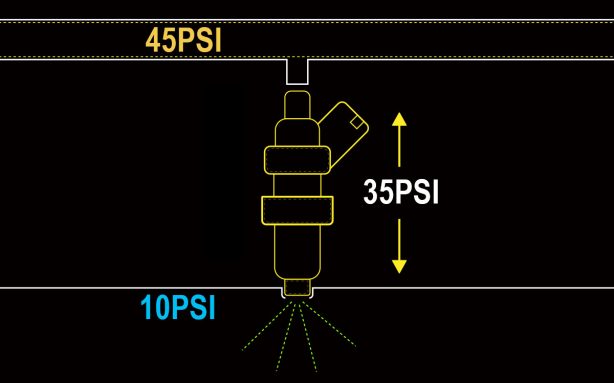Why you need a Fuel Pressure Regulator
A modern port fuel-injected engine has an electric fuel pump that feeds fuel from the fuel tank, up to the front of the car and through the fuel rails (which house the fuel injectors), through the fuel pressure regulator, then back the fuel tank.
A fuel pressure regulator’s job is to maintain a consistent fuel pressure across the fuel injector by regulating how much fuel’s returned to the fuel tank in order to maintain the desired fuel pressure.
The important thing to note is the fuel pressure needs to be consistent ACROSS the fuel injector not just at the tip.
A typical “base” fuel pressure is 3 bar or about 45psi which means that if we measure the pressure up the backside of the injector we’re going to see 45psi. Knowing that we can then determine the fuel injector flow rate. For Example, an injector commonly referred to as a “Bosch 1000” actually flows 1035cc at 45PSI and 1085cc at 50PSI. So that difference in “base” fuel pressure makes a difference to the amount of fuel the injector flows.
Why is that important? Most modern ECUs work by calculating the amount of air going into the engine at any given time, then adding the right amount of fuel in order to achieve the tuner’s desired Air to Fuel Ratio.
If the ECU has been told the wrong injector flow rate, the engine’s fueling and fuel corrections won’t be accurate and the tuner will have a hard time getting it right.
A huge factor here that’s often overlooked is the Manifold Pressure. If you have 45PSI of fuel pressure going up the backside of the fuel injector and 10PSI of boost pressure acting against the tip of the injector – you’ll end up with a “Differential Pressure” (or pressure across the injector) of 35PSI.
This means that all the fuel calculations would then need to work off an injector flow rate of 35PSI, not the 45PSI we had when we set the base fuel pressure. This is where a Manifold Pressure Referenced Fuel pressure Regulator comes in handy.
We use the Manifold Pressure Reference to maintain a consistent “Fuel Pressure Differential”. This way, when we put 10PSI of boost into the engine the fuel line pressure is INCREASED by 10PSI resulting in a fuel line pressure of 55PSI and a differential fuel pressure of 45PSI – the same as what we started with and resulting in the same injector flow rate, even though the fuel line pressure and the pressure acting on the tip on the injector has changed.
The same Fuel Pressure Regulator also works in reverse, when the engine is idling in vacuum, the base fuel pressure will be reduced to maintain the pressure across the injector because the vacuum in the inlet manifold is sucking the fuel out, resulting in the same injector flow rate but with less fuel pressure.

NOTE: The Base Fuel Pressure should be set with the fuel pump running and the vacuum hose disconnected from the fuel pressure regulator.
You can also map your Fuel Injector Flow Rate vs. Your Differential Fuel Pressure, that way if there are any discrepancies in your fuel system the ECU will always know exactly how much fuel your injectors are capable of flowing.
Related Articles
Fuel Pressure Sensor, Diagnosis, and Engine Protection
This guide is based on the TI 150 psi pressure sensor. Other sensors can be used however please check wiring and calibration data to suit the sensor. About Haltech Part HT-010904 A fuel pressure sensor is a sensor that can read up to around 150 to ...ECU controlled Nitrous Injection
Nitrous injection is one of the simplest and cost-effective ways to get more horsepower from your engine. Relatively easy to fit and set up, nitrous provides an instant power boost at your finger tips. How Nitrous Injection works Nitrous Oxide has ...Fuel Pressure Sensor
A Fuel Pressure Sensor can be used with your ECU for datalogging, injector pressure differential tuning and for Engine Protection purposes. A Fuel Pressure Sensor is a powered sensor that typically has three wires; a 5V+ power wire, a signal wire to ...Fuel
This section contains setup information for fuel configuration, including number of stages, injection mode, tuning method, and table selection. Page Contents Fuel Tuning Method Volumetric Efficiency Mass Air Flow Injection Time Auto V.E. Air Temp ...Fuel Tuning
The Fuel Tuning node configures the main Fuel Tuning related information for the engine. Fuel Tuning Method Sets the method for fueling calculation. Most installations will use Volumetric Efficiency. See also Fuel Base. Auto V.E Air Temp Compensation ...



